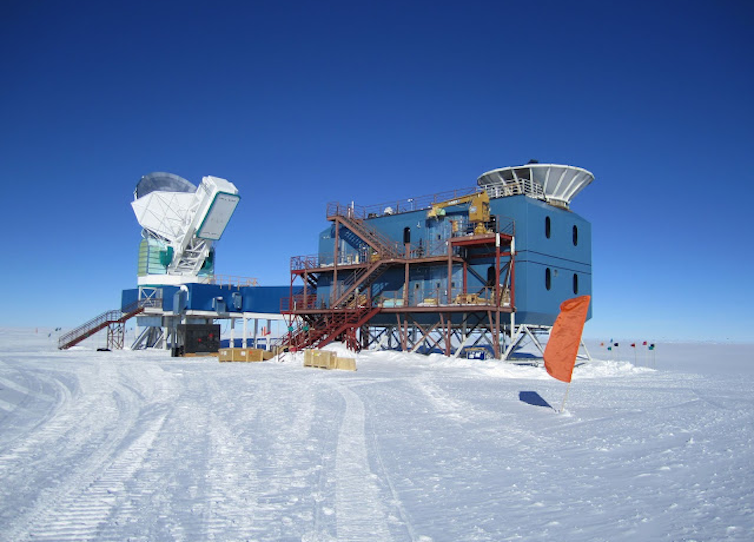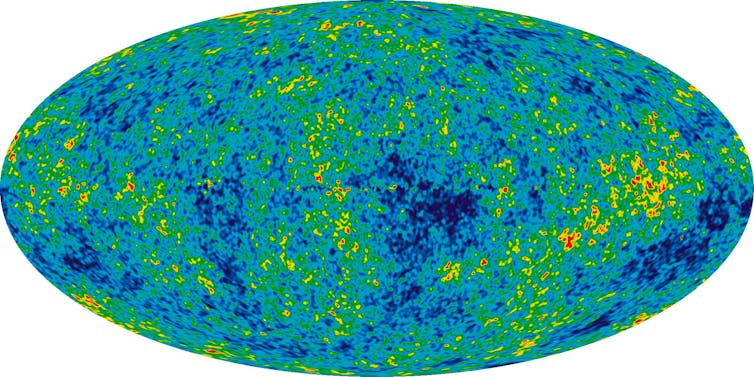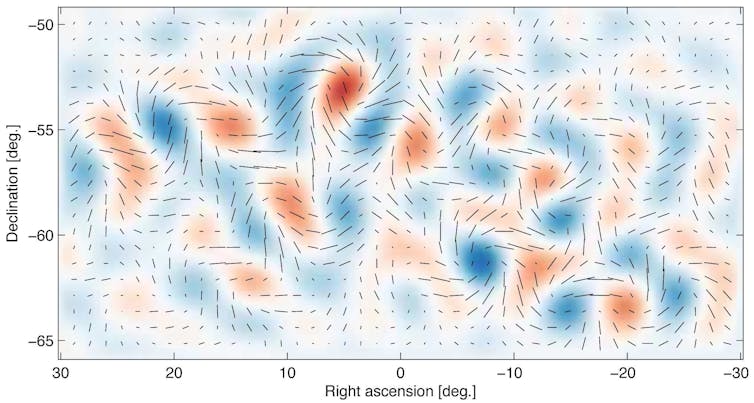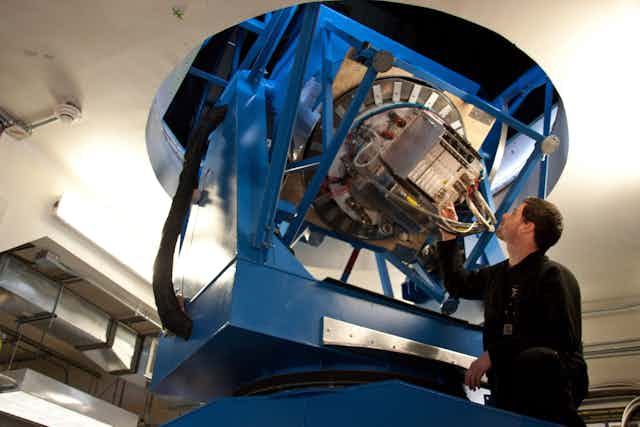Scientists at the Harvard-Smithsonian Centre for Astrophysics in the US have announced overnight what they believe is the indirect detection of gravitational waves in the afterglow of the Big Bang.
The discovery by the Background Imaging of Cosmic Extragalactic Polarisation (BICEP) collaboration, indeed even the rumours of such a discovery, sparked a huge discussion among the scientific community. Why?
As the last untested prediction of Einstein’s Theory of General Relativity, finding gravitational waves is a big deal.
The BICEP discovery provides further indirect evidence for the existence of gravitational waves (the 1993 Nobel Prize in Physics was awarded to Russell Hulse and Joseph Taylor for finding a double pulsar that strongly supported these “ripples” in spacetime).
Secondly, and most importantly, it advances our knowledge of the universe enormously.
Before this announcement, thanks to Big Bang nucleosynthesis (when light elements such as hydrogen and helium were created), we could measure the universe back to about a minute after the Big Bang.
The finding today has allowed us to study the universe when it was a trillionth of a trillionth of a trillionth of a second old, when so-called “inflation” took place.
Inflation was a period of accelerated expansion of the early universe, but before we explain what that is and why it’s so important, first a few words about what was actually detected by the BICEP telescope.

Cosmic microwave background
Everywhere astronomers point their (microwave) telescopes there is a faint glow of light. The picture formed from this (microwave) light is almost perfectly the same in all directions and corresponds to an object shining with a temperature of just 2.72548 Kelvin above absolute zero (or a chilly -270.42452 Celsius).
This afterglow of the Big Bang, called the cosmic microwave background (CMB), is a fossil radiation emitted when the universe was still very young, just 380,000 years old.

Why the CMB looks so similar in all directions was one of the greatest riddles of 20th century cosmology.
Another conundrum that puzzled astronomers was the source of tiny changes in temperature that were discovered by the COBE satellite (winning the 2006 Nobel Prize), and appearing as blue and red spots in the picture above from the WMAP satallite. Inflation provides a neat solution to these problems.
Inflation
So what does inflation mean for the early universe? Generically, inflation theories suggest the universe expanded from a tiny 10-33cm (the Planck scale) to many times larger than the visible universe today (>> 1028 cm).
This means that a small region of the young universe with the same temperature is expanded to larger than the entire observable universe, explaining why the observed CMB has such a similar temperature everywhere.
Furthermore, the world of the very small (governed by quantum mechanics) has been expanded into the realm of the very large. One thing that Quantum Mechanics tells us is that on the smallest scales everything fluctuates.
After inflation these tiny fluctuations are expanded to enormous scales, becoming the imperfections we see in the CMB. These are the gravitational seeds around which galaxies will later form.
The problem of why the CMB is so similar everywhere but not perfectly so is naturally answered by inflation.
There is another signature that inflation predicts. Fluctuations in not just what would become the normal matter we see in the CMB, but in a background gravitational field which delicately imprints itself on the light from the CMB.
This can’t be seen in the normal maps of the CMB (such as the above picture), but instead in the polarisation (the direction in which light oscillates as it travels) of the CMB.
Polarisation of the CMB
The BICEP telescope split the polarised CMB light into two types of shapes or “modes”: B-modes and E-modes.

It is relatively easy to create the E-modes and this pattern of polarisation has been known since 2002 with the DASI telescope.
Much harder to create (and a far weaker signal) is the B-mode. These can only come from gravitational lensing of the CMB light by intervening galaxies or gravitational waves from the early universe expanded to enormous scales by inflation. The B-mode polarisation induced by gravitational lensing was detected last year. Today it’s the turn of the gravitational waves.
Gravitational waves from the early universe
Alternative theories to inflation do not produce gravitational waves so the existence of B-modes detected by BICEP is strong evidence not only of the gravitational wave background but also inflation itself.
The B-mode signal of the gravitational waves is a bit stronger than previous efforts such as the Planck satellite had suggested.
This result implies the energy scales at which inflation kicks in is close to that of Grand Unified Theory, meaning that inflation could occur even sooner after the Big Bang.
It is also the first indirect detection of the gravitational wave background. So far there has still been no direct detection of the gravitational radiation.
The first direct detection should follow in a few months, when the Advanced Laser Interferometer Gravitational-Wave Observatory (or Advanced LIGO for short) will start to operate. It is envisaged that the experiment will directly detect gravitational radiation coming from astrophysical sources from nearby galaxies.
Gravitational insight into the origin of the universe
If today’s announcement by BICEP is confirmed by other experiments it will be a huge boost to the theory of inflation and the existence of gravitational waves.
Everything we know about the world around us is based on seeing light (electromagnetic waves). Yet this discovery opens up the possibility of an entirely new sense with which to view our universe – gravitational waves.
Who knows what they will allow us to see? At the very least we will be able to “see” into the hearts of exploding stars, or titanic collisions between galaxies and of course right back to the start of our entire universe as shown by this discovery.
It will allow us access to the unimaginable world of our universe just after the Big Bang and has already given hints of a new realm of physics, perhaps a more significant discovery for particle physics than even the confirmation of the Higgs Boson.
More accurate measurements of the gravitational waves across different scales on the sky will allow us to test models of inflation. All of which has taken us one step closer to answering the ultimate question of the nature of the Big Bang itself.

